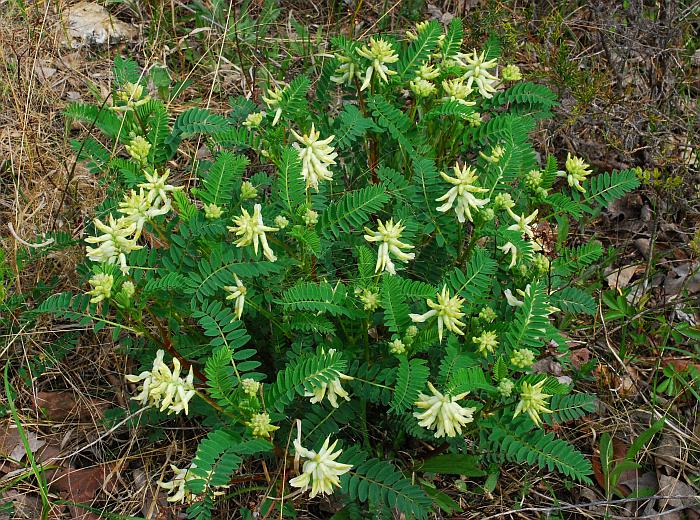Astragalus crassicarpus var. trichocalyx (Nutt. ex Torr. & A. Gray) Barneby ex Gleason
Ground Plum

Native
CC = 7
CW = 5
MOC = 54
© SRTurner
Astragalus crassicarpus var. trichocalyx (Nutt. ex Torr. & A. Gray) Barneby ex GleasonGround Plum | |
 |
Native CC = 7 CW = 5 MOC = 54 |
© SRTurner |
|
Family - Fabaceae/Faboideae Habit - Perennial forb, with a thick woody taproot below a branched caudex. Stems - Multiple from base, to 40 cm, loosely ascending to erect, branching, herbaceous, tan to reddish, sparsely to moderately pubescent with unbranched antrorse hairs, these more or less straight to curved and woolly, attached at the base.
Leaves - Alternate, odd-pinnate, stipulate. Stipules 3-9 mm long, 5 mm broad at base, lanceolate to ovate, acute to acuminate, free from the petiole and not sheathing the stem, membranous when young, papery at maturity. Leaves with the petiole 3-10 mm long, with 15-27 leaflets, the rachis 5-12 cm long. Leaflets 3-17 mm long, 3-7 mm wide, oblanceolate to oblong, elliptic, or nearly circular, rounded to more commonly pointed at the tip, entire but with cilia on margins, the upper surface glabrous to sparsely hairy, the undersurface moderately to densely branched-hairy. Petiolules to 1 mm long, pilose.
Inflorescence - Relatively short, spikelike racemes, 4-8 cm long, with 5-25 flowers, the bracts 2-5 mm long, usually hairy. Each flower subtended by a minute lanceolate bract, this to 3 mm long, 1mm broad at base, with green midvein.
Flowers - Ascending to spreading, the stalks 1-5 mm long, hairy; cleistogamous flowers absent. Calyces with the tube 3-9 mm long, cylindric to narrowly bell-shaped, not or only slightly pouched, moderately to densely hairy, the 5 lobes 1-3 mm long, triangular. Corollas papilionaceous, mostly greenish yellow to white, occasionally purplish, the banner 14-24 mm long, 4-6 mm wide, somewhat curved upward to nearly straight, glabrous, the wings 13-17 mm long, the keel 11-14 mm long, folded around style and stamens. Stamens diadelphous, with the fused portion 9-12 mm long, the free portion 1-2 mm long. Filaments glabrous, white, to 1.3 cm long. Anthers orange-red. Styles 6-8 mm long, greenish white.
Flowering - Fruits - Plump, 15-28 mm long, 12-20 mm wide, subglobose, tapered abruptly to a slender beak at the tip, fleshy when immature, becoming leathery with age, spreading to drooping, 2-locular, glabrous, often reddish- to purplish-tinged, tardily dehiscent or indehiscent. Seeds 2.0- 2.2 mm long, the surface dark brown to black, smooth or nearly so.
Flowering - April - May. Habitat - Upland open woods, glades, bluffs, rocky prairies. Origin - Native to the U.S. Lookalikes - A. canadensis. Other info. - This is an attractive species which can be found predominantly in the lower 2/3 of the state. Its U.S. distribution is relatively small, mostly restricted to Missouri, Arkansas, and Oklahoma. When flowering it is easy to identify, generally having numerous small, cream-colored inflorescences and flowers with wooly calyces. The variety shown here, var. trichocalyx, can be distinguished from the rarer var. crassicarpus by its longer inflorescence stalks and densely white-wooly calyces. The rarer variety also usually has purplish flowers. Photographs taken at the Piney Creek Wilderness, Mark Twain National Forest, Barry County, MO., 4-4-04, and at Whetstone Conservation Area, Callaway County, MO., 4-17-04 (DETenaglia); also at Valley View Glade Natural Area, Jefferson County, MO, 4-24-2009, Young Conservation Area, Jefferson County, MO, 4-24-2013 and 5-2-2013, St. Joe State Park, St. Francois County, MO, 5-3-2014 and 4-10-2017, and in Gasconade County, MO, 4-8-2021 (SRTurner); also at Valley View Glade Natural Area, Jefferson County, MO, 8-2-2021 (KBildner). |